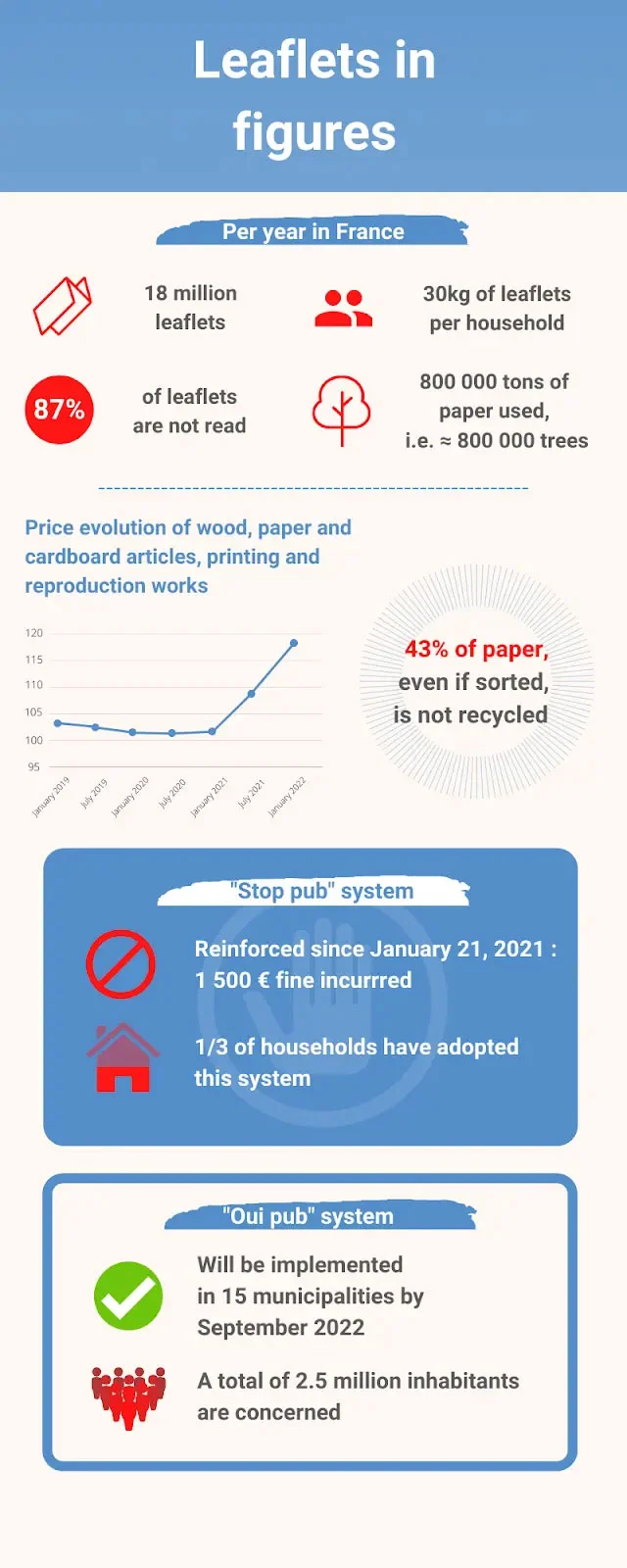Following the opt-in regulations for digital advertising, the French government is now planning to follow suit for print advertising. The initiative around “Oui Pub”, which means yes to advertising flyers, directly echoes the “Stop pub” message already frequently used on mailboxes in France to decline junk mail.
Consumers now have to actively opt in to receive flyers, similar to how the introduction of GDPR, which requires users to opt in, rather than opt out. People need to actively give their consent to receive promotional materials.
In this article we explain how this new opt-in system took shape, and discuss the advantages of online advertising compared with print, which have been evident for some time.
Background on the “Oui Pub” program
The French government announced that the new opt-in consent for printed flyers will be piloted in 15 local communities between now and 2025. On May 3, 2022, France made the decision to test the idea following a report written by the Minister of Ecological Transition. The new program means that paper flyers can only be delivered to households granting their consent. The aim is to essentially reduce the amount of printed flyers.
According to the website Planetoscope, 27 kg (nearly 60 lbs) of flyers and printed advertising materials are distributed to letterboxes. That’s 17 kg (37 lbs) of paper per household member, for 18 billion flyers per year. Unaddressed flyers represent a total marketing budget of € 2.8 billion per year, € 400 million of which is needlessly wasted. Moreover, with the production costs of wood, paper and cardboard set to rise, these figures are bound to increase. The French National Institute for Statistics and Economic Research, INSEE, predicts that the producer price index value will reach 120.6, representing an increase of 17.89% compared with last year (March 2021).
Flyers are currently widely used by retailers, but will become increasingly curtailed by measures such as the “Oui Pub” program, as people are becoming more environmentally conscious.

How to rethink your media mix
First off, what is a media mix? Advertisers are constantly trying to optimize their campaign strategies, as well as their budgets. A media mix means harnessing a combination of different advertising channels for an ad campaign. This means prioritizing different media based on the return of investment.
Because of the restrictions on the use of printed flyers and the ever-evolving nature of technology, retailers and distributors are gradually being forced to rethink their communication strategies. This is particularly true given that today people are online more than ever and the internet is such a pivotal part of consumers’ daily lives.
Hybrid communication
What is the best strategy? The solution is to customize a media mix, by using a hybrid communication strategy including digital flyers and digital advertising. This provides the best of both worlds.
- Digital flyers are cheaper and reduce waste (the perfect communication advantage for a CSR strategy).
- Digital advertising means you can target specific profiles using analytics tools which track performance, which in turn allows you to optimize costs.
For retailers that still prefer the flyer format, online alternatives are available which allow them to effectively share a digital flyer and replicate the printed flyer experience by featuring a wide range of products. Advertising agencies such as Azira can create a digital version of a paper flyer.
Some retailers already offer fully digital flyers on their websites. Many state in their corporate social responsibility roadmap that they are aiming to reduce the social and environmental impact of their activities. For some, e-commerce developments have meant that they can have a catalog that is 100% online.
Finding your media mix
There is no perfect media mix. As we already mentioned, the choice of media used in a communication strategy depends on several factors, each of which is specific to the brand. A media mix will be different for every brand, depending on consumer habits of the target audience, the advertiser’s budget, return on investment and other factors.
Individual retailers can develop a strategy to suit their specific needs and objectives, whether national or local. Depending on this, some brands will adopt a specific strategy using online and/or offline levers.
What are the advantages of online advertising over paper?
With technological developments and evolving consumer behavior, marketers are including more digital activities in their media strategy. This is particularly true following the “Oui Pub” program, where it makes sense to use digital tactics to respond to environmental and financial challenges.
Optimizing print format for online
Digital flyers have their benefits, both for consumers as well as advertisers. Extra functionalities can improve the catalog experience. For example, interactive features can be added to advertising materials.
Retailers can use video to help get the message across and clarify what they are offering. This will increase conversion rate in the long run. The same applies for using links. An online version of a flyer can also link directly to products and guide the customer towards a potential purchase.
For redirect links, we recommend integrating CTAs (Calls to Action) which send the user to a navigation app that directs them to the nearest point of sale. Buttons with CTAs such as “Let’s go” or “Get offer” can lead them to the store. This type of functionality strengthens consumer engagement and also increases conversion rates.
Finally, digital format allows retailers to include more products without using more paper. You can include a wide range of products, to demonstrate to customers the extent of your range and how you can respond to their potential needs.
Expanding your catchment area
The catchment area represents the perimeter from which the customers of a sales outlet would theoretically come. A catchment area would traditionally look at where consumers live, without taking into account where they, or people close to the area, travel (e.g., professionals commuting to work).
Direct mail, as we know it today, focuses on a fixed catchment area, focusing on where the potential customer lives. This concept is traditionally rooted in the distribution methods of a store manager, but can be complemented by analyzing online and offline behavior.
By combining online and offline data we are able to take into account more information to offer communication that is more personal to the consumer. Therefore, having geographical data (such as place of work or places they usually frequent), allows you to map consumer travel. This will shake up and reinvigorate your catchment area, which was previously focused only on where people lived.
The time and financial resources spent on mass mailing, based on a traditional catchment area, would be better spent on the customized communication processes described above. For example, consumers would receive personalized digital flyers, referring them to the nearest store through CTAs.
Digital flyers allow you to boost and broaden your catchment area. The physical time and cost spent on mail marketing are reduced with digital flyers and targeted to the right people based on their travel habits.
Tracking performance
With mailbox flyers you are unable to accurately measure performance. After sending a flyer, it is generally difficult for an advertiser to calculate their return on investment. How many customers really visited after receiving the flyer? Did they already plan to stop by before seeing the flyer?
You don’t know your real conversion rate. Online campaigns can be measured much more accurately, especially by monitoring the click-through rate. You can also use tracking UTMs in your flyer links, so you know the exact number of people that have clicked on your products.
If you want a more accurate idea of consumer response to your flyers, you can do A/B testing. Send two different versions of your visual to your contact list. See which gets most results and tweak your flyer as appropriate.
Digital flyers allow you to analyze performance, which in turn can help you develop a retargeting strategy. Knowing which profiles have already engaged with you allows you to target them with more personalized communication, optimizing the conversion rate for future campaigns.
Finally, you can track incrementality in your offline strategy. Also known as incremental measurement, this allows you to improve your media planning and optimize where you spend money. This strategy is very similar to offline A/B testing. It involves comparing the visit rate of group A who have seen one message, with group B who have not seen the message.
By having one group see the message and another not, you can calculate the potential increase in visits generated by the message you sent out. By comparing behavior of both groups, you have a better idea of how your campaigns are performing.
Post “Oui Pub” conclusions
The opt-in program is in line with current general attitudes and environmental awareness. It does not mean it is the death knell of printed flyers. As we have seen, hybrid marketing is a potential solution that can benefit retailers in a number of ways.
You can set up more repeat and profitable campaigns, while optimizing your ability to track performance in order to offer flyers that are tailored to your customers’ needs.




